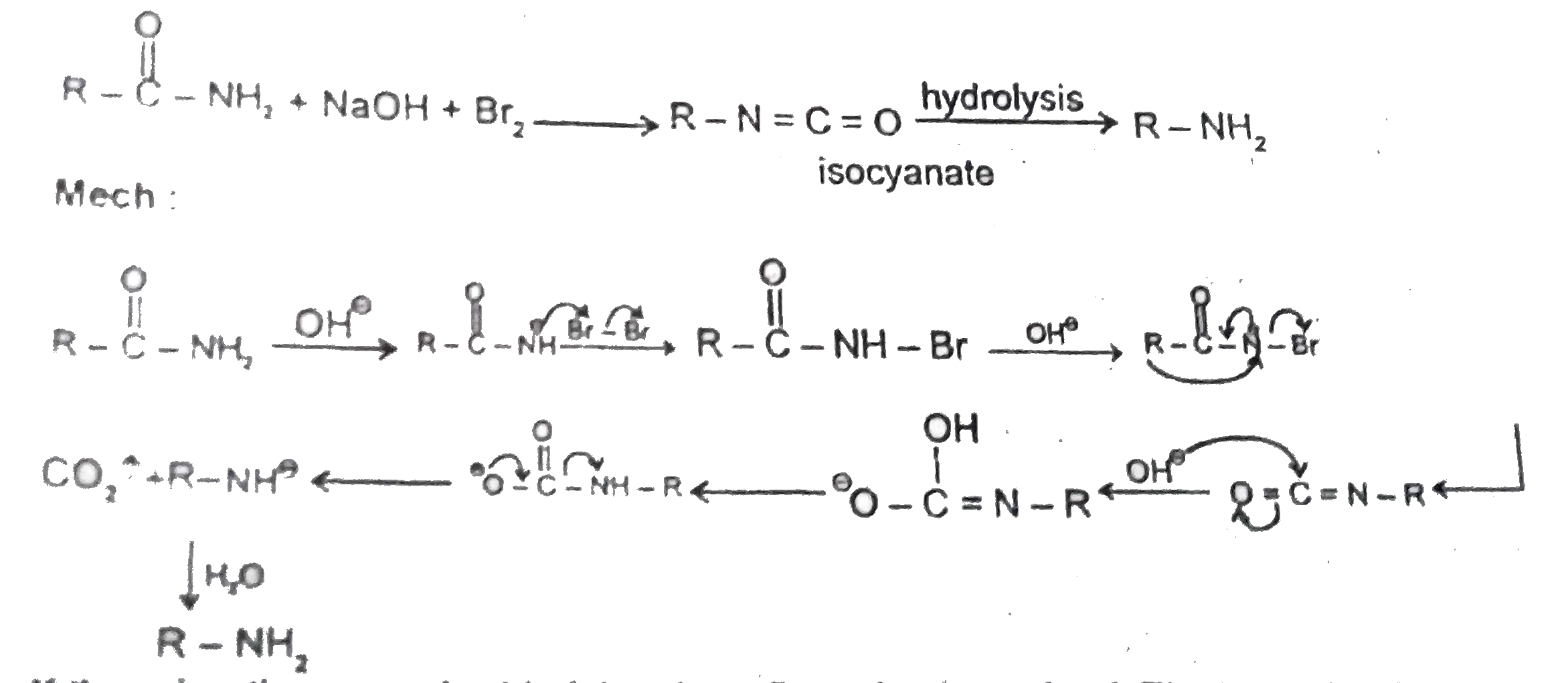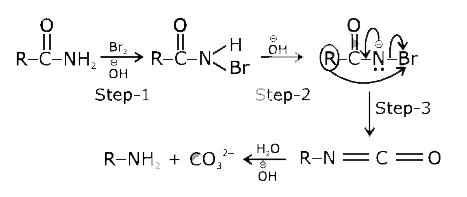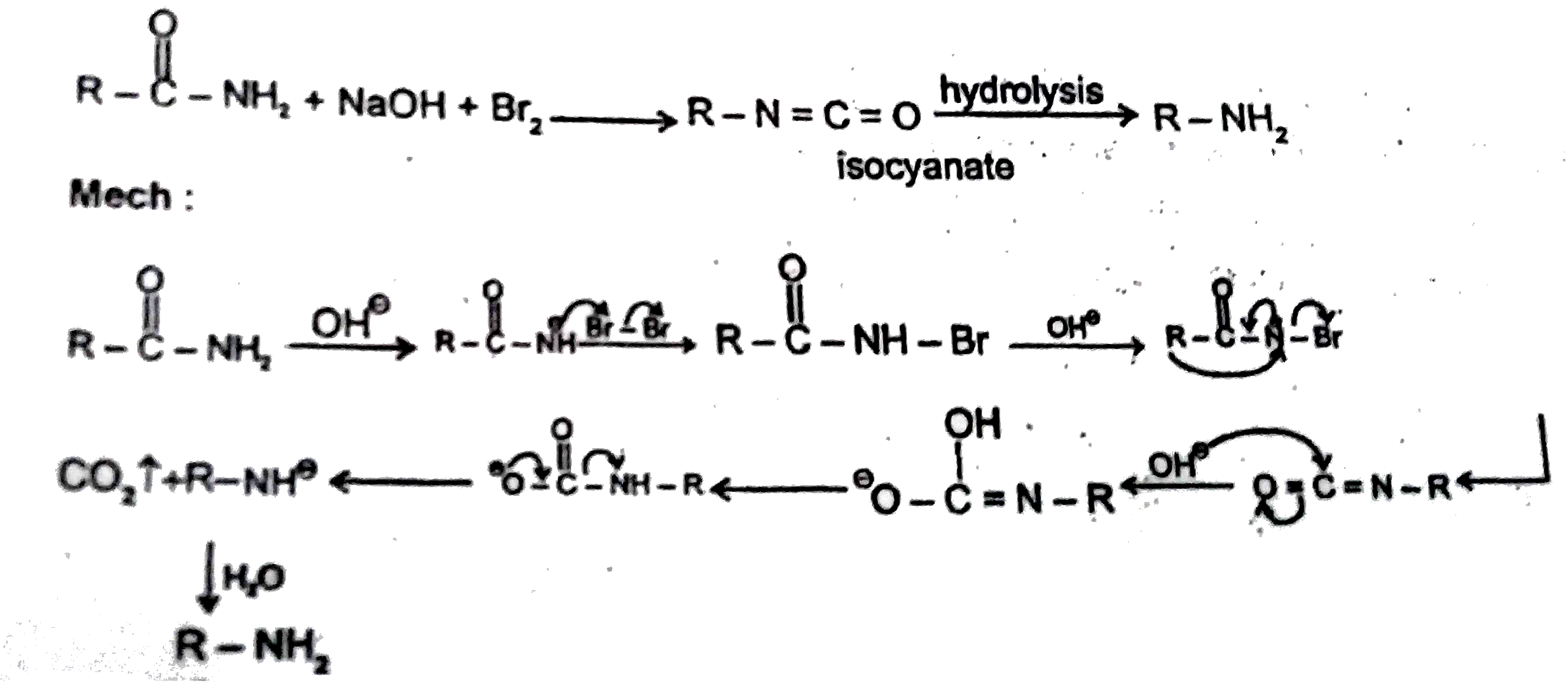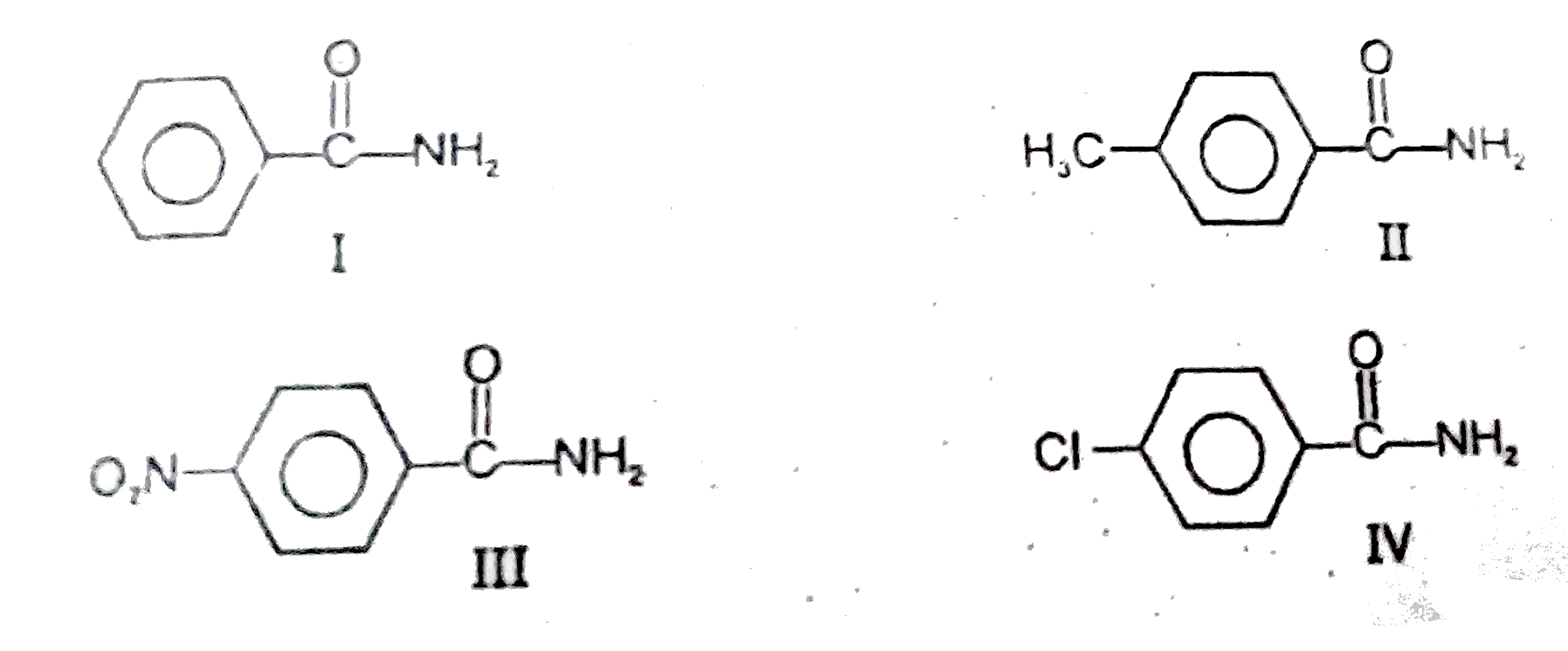In the Hoffmann rearrangement of primary amides having optically active group with S-configuration, the product amine has
R-configuration
S-configuration
racemic mixture
meso-form
The correct Answer is:B
To solve the problem regarding the Hoffmann rearrangement of primary amides with an optically active group having S-configuration, we can break down the process step-by-step.
1. Understanding the Starting Material:
- We start with a primary amide of the form R-C(=O)-NH2, where R is an optically active group with S-configuration.
2. Reagents Used:
- The reagents for the Hoffmann rearrangement include a halogen (like Br2) and a strong base (like NaOH or KOH).
3. Formation of N-haloamide:
- The primary amide reacts with the halogen to form an N-haloamide. This involves the substitution of the hydrogen atom on the nitrogen with a halogen atom (Br in this case).
- The structure now is R-C(=O)-NBr.
4. Base-Induced Rearrangement:
- The presence of a strong base facilitates the rearrangement. The base abstracts a hydrogen atom from the nitrogen, generating a negative charge on nitrogen.
- The R group migrates from the nitrogen to the carbonyl carbon, leading to the formation of an isocyanate intermediate.
5. Formation of the Product:
- The isocyanate then hydrolyzes in the presence of water (from the base), leading to the formation of a carbamic acid intermediate.
- The carbamic acid can then decompose to form the final amine product and carbon dioxide (CO2).
6. Retention of Configuration:
- Importantly, during the migration of the R group, the stereochemistry of the original optically active group is retained. Since the original configuration was S, the product amine will also have S-configuration.
7. Conclusion:
- Therefore, the product amine resulting from the Hoffmann rearrangement of a primary amide with an optically active group having S-configuration will also have S-configuration.
Final Answer:
The product amine has S-configuration.
- We start with a primary amide of the form R-C(=O)-NH2, where R is an optically active group with S-configuration.
- The reagents for the Hoffmann rearrangement include a halogen (like Br2) and a strong base (like NaOH or KOH).
- The primary amide reacts with the halogen to form an N-haloamide. This involves the substitution of the hydrogen atom on the nitrogen with a halogen atom (Br in this case).
- The structure now is R-C(=O)-NBr.
- The presence of a strong base facilitates the rearrangement. The base abstracts a hydrogen atom from the nitrogen, generating a negative charge on nitrogen.
- The R group migrates from the nitrogen to the carbonyl carbon, leading to the formation of an isocyanate intermediate.
- The isocyanate then hydrolyzes in the presence of water (from the base), leading to the formation of a carbamic acid intermediate.
- The carbamic acid can then decompose to form the final amine product and carbon dioxide (CO2).
- Importantly, during the migration of the R group, the stereochemistry of the original optically active group is retained. Since the original configuration was S, the product amine will also have S-configuration.
- Therefore, the product amine resulting from the Hoffmann rearrangement of a primary amide with an optically active group having S-configuration will also have S-configuration.
The product amine has S-configuration.
Topper's Solved these Questions
- ORGANIC COMPOUNDS CONTAINING NITROGEN BOOK - MODERN PUBLICATIONCHAPTER - ORGANIC COMPOUNDS CONTAINING NITROGEN EXERCISE - Competition File (C) MULTIPLE CHOICE QUESTIONS
9 Videos
- ORGANIC COMPOUNDS CONTAINING NITROGEN BOOK - MODERN PUBLICATIONCHAPTER - ORGANIC COMPOUNDS CONTAINING NITROGEN EXERCISE - Competition File (D) MULTIPLE CHOICE QUESTIONS (based on the given passage/comprehension )
7 Videos
- ORGANIC COMPOUNDS CONTAINING NITROGEN BOOK - MODERN PUBLICATIONCHAPTER - ORGANIC COMPOUNDS CONTAINING NITROGEN EXERCISE - Competition File (OBJECTIVE TYPE QUESTIONS) (MULTIPLE CHOICE QUESTIONS (M.C.Q)) (A)
30 Videos
- HALOALKANES AND HALOARENESBOOK - MODERN PUBLICATIONCHAPTER - HALOALKANES AND HALOARENESEXERCISE - UNIT PRACTICE TEST
11 Videos
- POLYMERSBOOK - MODERN PUBLICATIONCHAPTER - POLYMERSEXERCISE - Competition file (OBJECTIVE TYPE QUESTIONS) (C. MULTIPLE CHOICE QUESTIONS)(Integer Type Questions)
6 Videos
Similar Questions
Number of primary amines having molecular formula are
View SolutionHofmann rearrangement
In the Hoffmann rearrangement an unsubstituted amide is treated with sodium hydroxide and bromine to give a primary amine that has one carbon lesser than starting amide.
R−O∣∣C−NH2+NaOH+Br2→R−N=C=Oisocyanatehydrolysis−−−−−→R−NH2
Mech :

If the migrating group is chiral then its configuration is retained . Electron releasing effects in the migrating group increases reactivity of Hofmann rearrangement.
Which of the following compound cannot give Hofmann rearrangement :
View Solution
Knowledge Check
Which of the following amines is optically active ?
ACH3NH2BCH3NHCH3CCH3CH2CH2−CH3∣N−C2H5Dsec-ButylamineWhich of the following amines is optically active ?
ACH3NH2BCH3NHCH3C Dsec-Butylamine
Dsec-ButylamineThe conversion of an amide into an amine with one carbon atom less by the action of alkaline hydrohalite is known as Hofmann bromamide rearrangement:
RCONH2Br2/KOH−−−−−−→R−NH2
The most important feature of the reaction is the arrangement of N–bromamide anion to isocyanate :

The product of the reaction

Product amine will be :AS-amineBR-amineC50:50 mixture of (+) and (–) amineD30:70 mixture of (+) and (–) amine
Hofmann rearrangement
In the Hofmann rearrangement an unsubstitued amide is treated with sodium hydroxide and bromine to give a primary amine that has one carbon lesser than starting amide.
Gneral reaction:
If the migrating group is chiral then its configuration is retained. Electron releasing effects in the migrating group increase reactivity of Hofmann rearangement.
Which of the following compound(s) cannot give Hoffman rearrangement:
View SolutionHofmann rearrangement during the conversion of an amide to amine is
View SolutionHofmann rearrangement
In the Hoffmann rearrangement an unsubstituted amide is treated with sodium hydroxide and bromine to give a primary amine that has one carbon lesser than starting amide.
R−O∣∣C−NH2+NaOH+Br2→R−N=C=Oisocyanatehydrolysis−−−−−→R−NH2
Mech :

If the migrating group is chiral then its configuration is retained . Electron releasing effects in the migrating group increases reactivity of Hofmann rearrangement.
Arrange the following amides according to their relative reactivity when react with Br2 in excess of strong base

View SolutionHofmann rearrangement
In the Hofmann rearrangement an unsubstitued amide is treated with sodium hydroxide and bromine to give a primary amine that has one carbon lesser than starting amide.
Gneral reaction:
If the migrating group is chiral then its configuration is retained. Electron releasing effects in the migrating group increase reactivity of Hofmann rearangement.
Arrange the following amides according to their relative reactivity when reacted with Br2 in excess of strong base:

View SolutionHofmann rearrangement
In the Hoffmann rearrangement an unsubstituted amide is treated with sodium hydroxide and bromine to give a primary amine that has one carbon lesser than starting amide.
R−O∣∣C−NH2+NaOH+Br2→R−N=C=Oisocyanatehydrolysis−−−−−→R−NH2
Mech :

If the migrating group is chiral then its configuration is retained . Electron releasing effects in the migrating group increases reactivity of Hofmann rearrangement.
H3C−H2C−∗C∣CH3(R)H−O∣∣C−NH2+CH3−CH2−D∣C∣CH3(S)−O∣∣C−15NH2Br2/KOH−−−−−−→Products
View Solution
